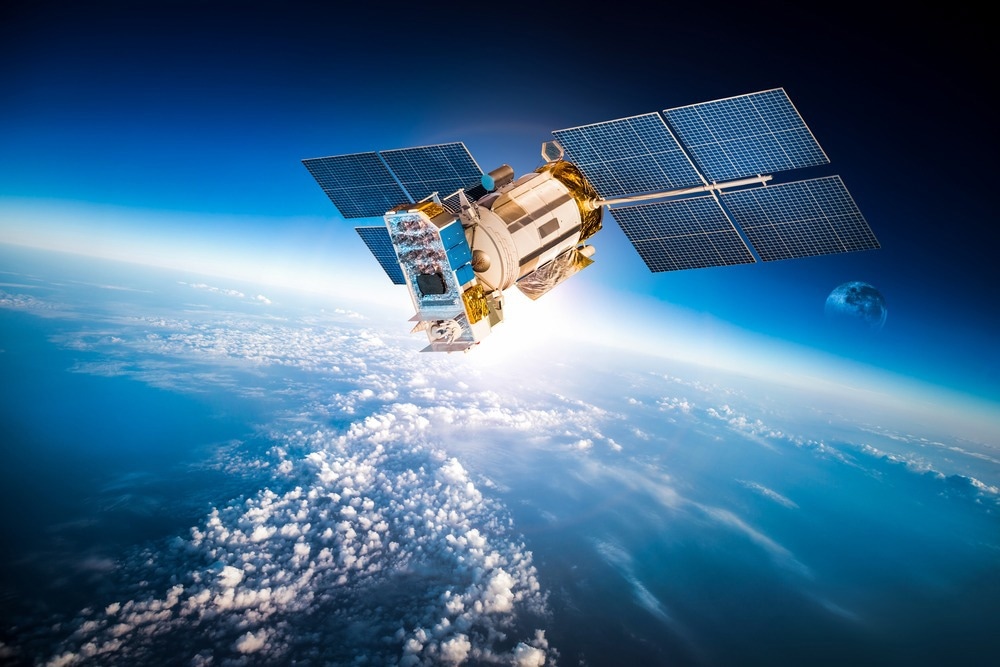In a paper recently published in the open-access journal ACS Energy Letters, researchers reviewed the use of perovskite-based photovoltaics (PV) for space applications. Additionally, the impact of the space environment on the type of PV components and their architecture was considered to discuss the extra-terrestrial potential of perovskite solar cells (PSCs).

Study: Advances in Perovskites for Photovoltaic Applications in Space. Image Credit: Andrey Armyagov/Shutterstock.com
Background
Owing to the high launching costs of spacecraft, the weight of the components, such as the energy generation devices, is a crucial parameter. Modern spacecraft derive energy from PV cells which are preferred over fuel cells, nuclear power, and batteries due to the widespread presence of solar energy in space.
However, suitable materials need to meet several requirements such as resistance to the space environment, high power conversion efficiency (PCE), low weight, and high gravimetric power. The III-V semiconductor-based Si and multijunction are the current primary materials used for light harvesting in solar cells (SCs) in space applications.
In the past decade, the physicochemical characteristics of metal halide perovskites (MHPs) seemed promising for the realization of perovskite solar cells (PSCs) which rivaled older technologies such as Cu(In,Ga)Se2 (CIGS) and Si. MHPs are successful in their application for PSCs due to their high absorption coefficient, high defect tolerance, and low excitation binding energies. Furthermore, the possibility of tweaking the optoelectronic properties coupled with the low weight and low production costs make PSCs a promising alternative in extra-terrestrial PVs.
Space Environment and its Impact on Materials
The space environment is described by seven factors, namely, plasma, the geomagnetic field, radiation, the neutral atmosphere (comprising atomic oxygen, high vacuum conditions, and atmospheric drag), debris, thermal fluctuation, and solar activity.
Although space debris is dangerous for spacecraft, it does not affect the physicochemical characteristics of the materials. Atmospheric oxygen can cause severe corrosion, while vacuum can lead to material effusion and outgassing, adhesion, evaporation, sublimation, and cold welding. Furthermore, both hot and cold plasma can trigger surface charging followed by power loss, electrostatic discharge, as well as short circuits in PV and electronic components. Thermal fluctuations can cause eventual rupture of the materials due to thermal contraction and expansion, and vibrations. Radiation damage on materials can be induced by interactions with either directly ionizing (charged particles interacting with electron clouds) or indirectly ionizing (photons and neutrons).
Radiation Resistance of MHPs
The intrinsic instability that MHPs experience when they are photo-excited makes it difficult to evaluate their resistance to the space environment. Therefore, it can get tricky to differentiate the impact of each degradation source. The proton irradiation can result in the dissociation of N-H and C-H bonds, followed by the discharge of H+ ions in the MHP structure. Post irradiation, the already existing structural defects as well as the ones formed during irradiation are passivated by the H+ ions.
The evaluation of the proton-induced quantum efficiency (PEQE) variation suggests that the resistance of MHPs to proton irradiation is far greater than that of SiC, leading the path for proton detectors based on MHPs. Further studies show that the photovoltaic performance of these detectors remains unaffected by 20 MeV protons but exhibits declining performance on irradiation by 68 MeV protons, possibly due to the increase of Schockley-Read-Hall (SRH) recombination.
This review also studied the space issues surfacing due to indirect ionizing radiations, such as ɣ rays, which cannot be blocked by shielding strategies because of their greater penetration depth. Although the atoms can be displaced by ɣ-rays from the perovskite crystal’s lattice sites causing defects, this can be reversed due to the ion-migration property of the MHPs. However, neutron-induced atom displacements are irreversible, causing lattice defects such as Frenkel defects.
Effects of Space Environment on PSC Design
The overall low-weight requirement of the device makes the role of the substrate material as crucial as that of the PSCs. Since glass substrates undergo radiation-induced darkening, it is preferable to use quartz substrates as they are lighter than common glass as well.
PSCs that contain organic transporting layers or TiO2 can be damaged by UV radiation. According to the authors, the planar structure should therefore be considered to fabricate PSCs cheaply and easily. PSCs can also undergo delamination due to thermal cycling.
Conclusions
To summarize, this review demonstrated that the use of MHPs for the realization of PSCs can be an effective solution to the space PVs market, exhibiting greater radiation tolerance. However, understanding the degradation mechanism of PSCs is still a challenge since it is difficult to distinguish between the radiation impacts due to aging and illumination.
Disclaimer: The views expressed here are those of the author expressed in their private capacity and do not necessarily represent the views of AZoM.com Limited T/A AZoNetwork the owner and operator of this website. This disclaimer forms part of the Terms and conditions of use of this website.
Source:
Valentino Romano, Antonio Agresti, Rosaria Verduci, and Giovanna D’Angelo. Advances in Perovskites for Photovoltaic Applications in Space ACS Energy Letters 0, 7 DOI: 10.1021/acsenergylett.2c01099. https://doi.org/10.1021/acsenergylett.2c01099